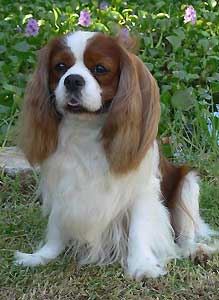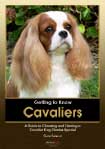Breed Type
Toy
History
Cavalier ancestors can be traced back to 11th century England, to a period in history where Toy Spaniels were the preferred hunting dog. By the 16th century these Spaniels became popular as companions to ladies of the royal court and children in royal households, and were selectively bred to suit this function. They were later crossed with other dogs such as the Pug and Japanese Chin, as fashions in England led to an increase in popularity of Asian breeds. In the early 1900's however, there was interest in reviving the breed of Toy Spaniel seen before the introduction of the Asian influence, and so these characteristics were selectively bred out, giving rise to the Cavalier King Charles Spaniel, which gained recognition as a breed in its own right in 1945.
Description
Small, well balanced, graceful dog with a flattish head, a fairly short and slightly tapering muzzle, and long silky ears. They have a gentle expression, with large warm, brown eyes, and come in various colour combinations of red, chestnut, black, tan and white.
Size
30-33 cm (12-13 inches) at the shoulder, and 5-8 kg (10-18 pounds).
Coat
Moderately long, silky coat, often with a slight wave, and long feathering on the ears, chest, legs, feet and tail. Requires regular grooming (perhaps weekly) to prevent matting and tangling, with perhaps more frequent attention being paid to the long hair on the ears. Hair between foot pads needs regular trimming.
Longevity
Temperament
Very friendly, gentle, playful dogs with an endearing nature. Affectionate, patient, social, and fun-loving. "Strangers are only friends they haven't met yet".
Health
Apart from a couple of serious genetic disorders, the breed is quite sound, retaining the sporting build of its ancestors. It may be prone to ear infections and obesity if not managed correctly. Cavaliers will not thrive if denied the companionship they have been bred for.
Possible Genetic Disorders
Cavaliers are particularly prone to a cardiac disease known as Mitral Valve Dysplasia (MVD). They are also somewhat prone to Hip Dysplasia and Luxating Patellas, as well as a number of serious eye diseases including Cataracts, Retinal Dysplasia, Corneal Dystrophy, Microphthalmia and Progressive Retinal Atrophy (PRA). Health screening for these disorders is available, and should form part of any discussion when considering a purchase. A serious neurological disorder called Syringomyelia is also of growing concern, but there is currently no test available to screen for it.
Best Suited
- Apartment, house or country, provided most time can be spent indoors
- Household with plenty of human contact
- Household with children
- Household with retirees
Worst Suited
- Households where the dog will be left alone for long periods
Recommended Reading
 Getting to Know Cavaliers: A Guide to Choosing and Owning a Cavalier King Charles Spaniel by Cathy Lambert
Getting to Know Cavaliers: A Guide to Choosing and Owning a Cavalier King Charles Spaniel by Cathy Lambert




